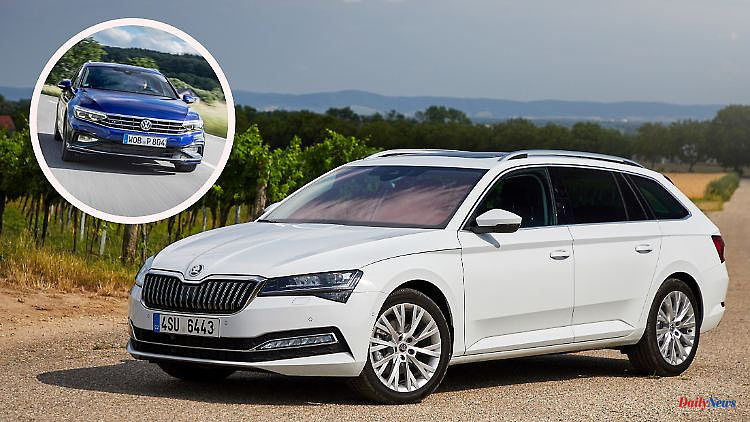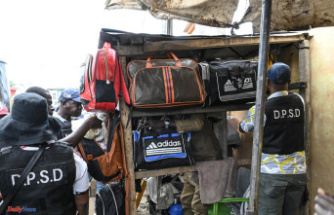Both the Škoda Superb and the Volkswagen Passat are solid touring cars at an affordable price. Of course it depends on the engine. ntv.de has the two mid-range station wagons once felt on the tooth.
Cars are not among the products that are becoming more attractively priced in the energy and economic crisis. After all, their production of all things consumes a lot of energy and the general shortage of materials is not exactly relaxing. Anyone who now trudges into the dealership with the calculation to get hold of the mature mid-range station wagons Škoda Superb and Volkswagen Passat for a small euro, because the successors are not that long in coming, will be disappointed. Although the relevant portals for online car purchases sometimes show a 20 percent discount for the Passat, which is still a brisk purchase even in the late phase of its life, such discounts are also available for the brand new ID.5. The Škoda Superb is listed with a discount of around 25 percent, here the bargain hunters are more likely to laugh.
But so that they know what they are getting themselves into, ntv.de has dealt extensively with the middle classes. Since the Czechs are generally always a bit between the chairs when it comes to segmentation with their models, the Superb is also a bit larger. As a station wagon, it measures 4.86 meters - so you really get a stately vehicle. At 2.84 meters, its wheelbase is not bad either.
So it's easy to decide to sit down on the rear seat bench first. It's actually quite comfortable, but what's really striking is the space between the end of the seat cushion (and therefore the kneecap) and the front seat back. A luxury class can hardly feel better. Of course, the 4.78 meter long Passat - wheelbase at least 2.79 meters - also offers flawless seating in the back, that's clear.
A middle class is so sprawling these days that it can easily carry a family of four comfortably, even to distant destinations. That's what she's there for. And to load one or the other transport object. Thanks to their king-size dimensions, both the Passat and the Superb are ideally suited for this, with 1,780 and 1,950 liters respectively of trunk volume with the rear seats folded down - this would make it clear who the undisputed champion is here. Incidentally, this also applies to all brands and segments, more loading space than the large Škoda offers like no other station wagon.
The question remains: which engine to take? In line with the characters, ntv.de has opted for the self-igniter for the middle-class Passat. Although the 200 hp are no longer quite so bourgeois, which shakes its most powerful two-liter diesel from the crankshaft - but it still remains under the 240 of the earlier top version with double turbocharging. Anyone who often travels longer distances and wants a superior drive is well on the way with the current single turbo of the highest performance level.
The middle-class car, which then costs at least 49,170 euros, is not stingy with sprint power and pushes the 1.8-tonner to 100 km/h within seven and a half seconds. The fact that the earlier twin turbo processed this discipline one and a half seconds faster is probably due less to the additional 40 hp and more to the excellent response of the machine. Although the TDI balances a whopping 400 Nm from 1750 revolutions on the front axle, so that grip suddenly becomes scarce. Until then, however, the torque build-up is sluggish, which is associated with a massive starting weakness.
Anyone who feels safer with all-wheel drive should pay the additional price of 2665 euros required for this, provided the budget plays along. The cheapest way to drive the Passat Variant is to order the 150 hp basic petrol version from a price of 34,725 euros. However, the powerful diesel already has features such as automatic transmission, parking assistance, a particularly comfortable ergo seat on the driver's side and adaptive cruise control as standard. Weaker diesels with 122 or 150 hp (from 37,470 euros) are also available.
Škoda also priced the slightly larger Superb higher, demanding at least 40,260 euros for the "Combi" with 150 hp petrol power. The test car discussed here starts with 280 hp from a turbocharged two-liter four-cylinder petrol engine. cost point? Not less than 54,950 euros - but with all-wheel drive already on board. Moreover, it is the luxurious "Laurin
But even the top model leaves room for improvement in terms of equipment and can further strain the budget. For example, with technology packages that are somewhere between 2000 and 3000 euros. How about the "Business Columbus" package for 2790 euros? It includes a navigation system along with a 9.2-inch touchscreen in a classy glass look plus extensive driver assistance with active steering and distance cruise control. Another, supplementary assistance package with a so-called trailer maneuvering assistant, fatigue warning, active tire pressure monitoring and lane change assistant costs 2270 euros.
Do you need that? Probably not, because every vehicle has a passive tire pressure monitor anyway, which also works and reports that the tire pressure is dropping (the computer at the gas station displays the values). Lane keeping assistants often fail because the lanes are often not recognized in practice - especially in the construction area. And drowsiness warnings report a condition that you are usually familiar with anyway. However, if you want to be reminded that you should take a break, then the fatigue warning is of course great.
But back to the drives. The Superb's powerful two-liter four-cylinder makes the Czech an inconspicuous Autobahn Express with a top speed of 250 km/h. Despite the enormous nominal power, it has lost its bite since the European Union tightened exhaust gas legislation. You wouldn't expect the 1.7 ton station wagon to hit 100 km/h in 5.3 seconds. You would just as well take 30 or 40 hp less off it. However, the power reserves are still more than ample, no question. But the incomparably more economical Passat TDI (5.4 l diesel/100 km compared to 7.6 to 9 l petrol/100 km in the average WLTP consumption) is a superior tourer that can travel fast - over 230 km/h can.
Both station wagons have sensitive chassis to finely smooth rough slopes even with wheel sizes larger than 17 inches. And the built-in automatic in both cases in the form of a seven-speed dual-clutch transmission perform the gear changes largely smoothly. However, the double couplers, which are considered efficient, do not allow their vehicles to start quite as gently as a classic torque converter. Above all, the creep (i.e. slow rolling when you let go of the brake) is more velvety with the converter. Within the group, however, they only exist in the higher segments.
Finally, a word about infotainment and operation: Both models use large touchscreens, the surfaces of which react quickly and run almost all functions. Nevertheless, both in the Passat and in the Superb, everyday features such as climate control can be commanded using a classic push button.
It remains to be hoped that this philosophy will also be carried over into the next generation of models. Because too much menu is in no way conducive to ease of use. Neither does security, because haptic buttons can be operated almost without distraction in contrast to smooth monitor surfaces. Škoda's "Simply Clever" philosophy will certainly continue. After all, who would want to do without the small rubbish bin in the door pocket, the ice scraper in the fuel filler cap or even the umbrella in the door? Even.












